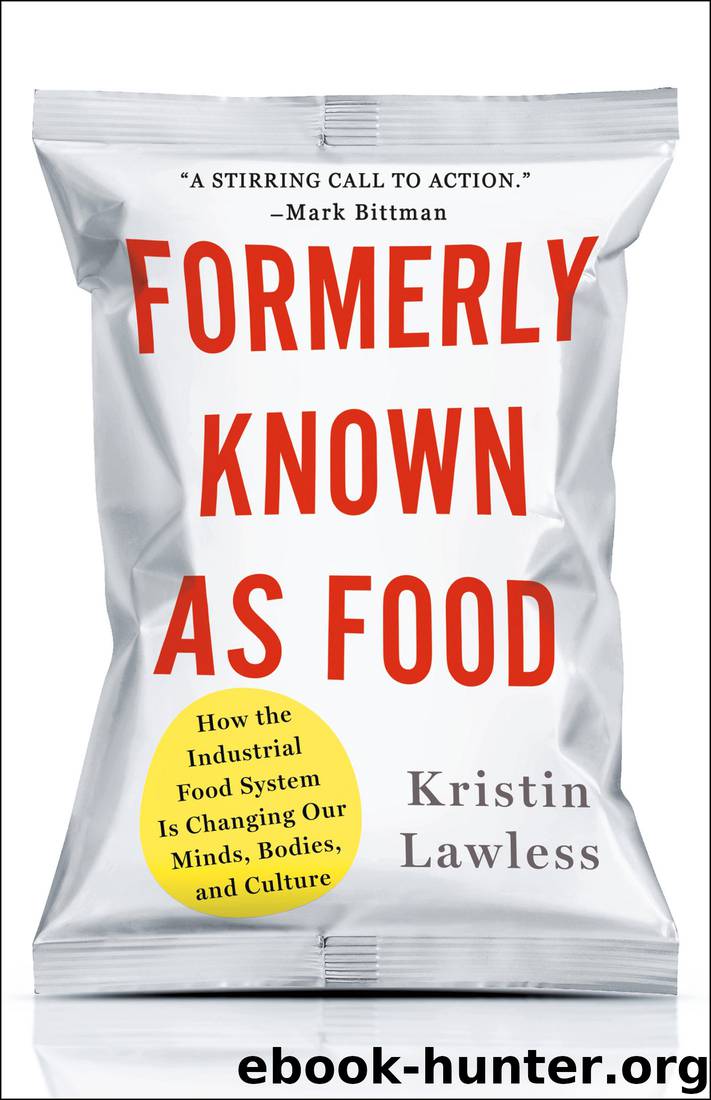Formerly Known as Food: How the Industrial Food System Is Changing Our Minds, Bodies, and Culture by Kristin Lawless

Author:Kristin Lawless
Language: eng
Format: epub
Tags: Agriculture & Food, Agriculture & Food Policy, Health & Fitness, Healthy Living, Human Anatomy & Physiology, Life Sciences, Political Science, Public Policy, Science, Social Science
Publisher: St. Martin's Press
Published: 2018-06-19T03:00:00+00:00
7
Our “Safe” Exposure to Toxic Chemicals
How the Regulatory Agencies Are Failing to Protect Our Health
There was a big news story in July 2017 in the Well section of The New York Times with a headline that read: “The Chemicals in Your Mac and Cheese.” Researchers found plasticizers, known as phthalates, in the popular kids food. Then, less than two weeks later, the Times’s Food section reported that traces of the herbicide glyphosate, the main ingredient in Roundup, had been found in Ben & Jerry’s ice cream.1 Several people asked me about it: Should we be worried? Yes, we should be worried, but not just because researchers found plasticizers in our mac and cheese or herbicide in our ice cream. We should be worried because these kinds of environmental chemical contaminants are literally everywhere, lurking in nearly all our foods. We know they exist in these two foods because researchers specifically looked for them. Roughly nine thousand environmental chemicals on the market end up in our foods, including food additives, colorings, flavorings, pesticides, and food-packaging chemicals.2 They are ever present in our environment and in our bodies, and the regulatory agencies whose job is to test and monitor them are failing to protect us. In dozens of interviews with scientists, researchers, and professors, I have identified major roadblocks to the fair and impartial regulation of environmental chemicals that we are all in direct contact with on a day-to-day basis, especially those in our foods.
Two main agencies are responsible for regulating all the environmental chemicals in our foods: the Food and Drug Administration (FDA) oversees all food and food ingredients on the market (except meat, poultry, and certain processed egg products, which are overseen by the U.S. Department of Agriculture), and the Environmental Protection Agency (EPA) regulates pesticides, herbicides, insecticides, and fungicides used in food production. But the laws governing the agencies have myriad problems, as do the agencies themselves. As a result, we are not being protected from the essentially unregulated industries that manufacture all the substances that end up in our food and in our bodies.
Chemical Manufacturers Provide Their Own Data
One of the fundamental flaws in the design of the regulatory system is that the manufacturers of the pesticides, emulsifiers, and plasticizers that are added to our food supply, food products, and food packaging provide their own data conducted by scientists that they hire to perform safety testing on their products. Let me repeat that: The manufacturers of the substances that lace our food supply and make their way into our bodies provide the safety data and their own evaluations to the regulatory agencies for review. In the case of pesticides, an EPA spokesperson told me that this practice is intended to save taxpayers money on expensive research and scientific studies. “Congress placed this obligation on the pesticide registrant rather than requiring taxpayers [to] fund data development,” the representative said. Most people would assume that the governmental agencies are doing independent testing to ensure the safety of our foods and other products in contact with our foods.
Download
This site does not store any files on its server. We only index and link to content provided by other sites. Please contact the content providers to delete copyright contents if any and email us, we'll remove relevant links or contents immediately.
| Automotive | Engineering |
| Transportation |
Whiskies Galore by Ian Buxton(41529)
Introduction to Aircraft Design (Cambridge Aerospace Series) by John P. Fielding(32888)
Small Unmanned Fixed-wing Aircraft Design by Andrew J. Keane Andras Sobester James P. Scanlan & András Sóbester & James P. Scanlan(32573)
Craft Beer for the Homebrewer by Michael Agnew(17933)
Turbulence by E. J. Noyes(7700)
The Complete Stick Figure Physics Tutorials by Allen Sarah(7138)
Kaplan MCAT General Chemistry Review by Kaplan(6595)
The Thirst by Nesbo Jo(6436)
Bad Blood by John Carreyrou(6274)
Modelling of Convective Heat and Mass Transfer in Rotating Flows by Igor V. Shevchuk(6222)
Learning SQL by Alan Beaulieu(6035)
Weapons of Math Destruction by Cathy O'Neil(5829)
Man-made Catastrophes and Risk Information Concealment by Dmitry Chernov & Didier Sornette(5646)
Digital Minimalism by Cal Newport;(5389)
Life 3.0: Being Human in the Age of Artificial Intelligence by Tegmark Max(5184)
iGen by Jean M. Twenge(5161)
Secrets of Antigravity Propulsion: Tesla, UFOs, and Classified Aerospace Technology by Ph.D. Paul A. Laviolette(4990)
Design of Trajectory Optimization Approach for Space Maneuver Vehicle Skip Entry Problems by Runqi Chai & Al Savvaris & Antonios Tsourdos & Senchun Chai(4839)
Electronic Devices & Circuits by Jacob Millman & Christos C. Halkias(4748)
